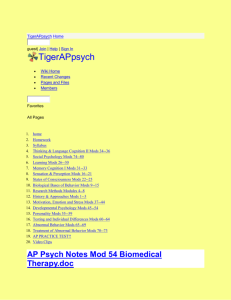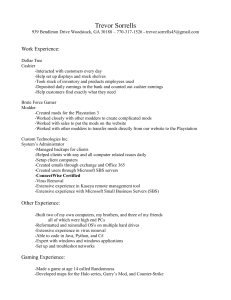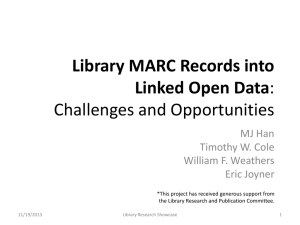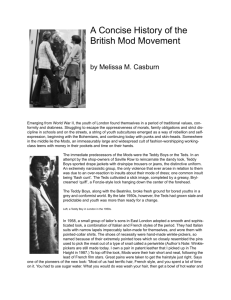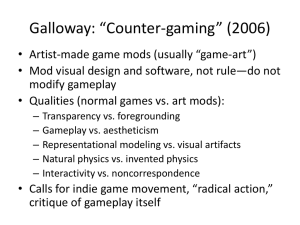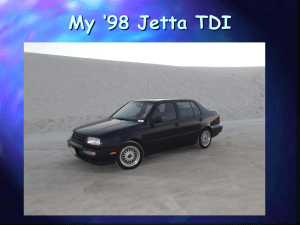Chi-Kent_J_Intell_Prop_196
advertisement
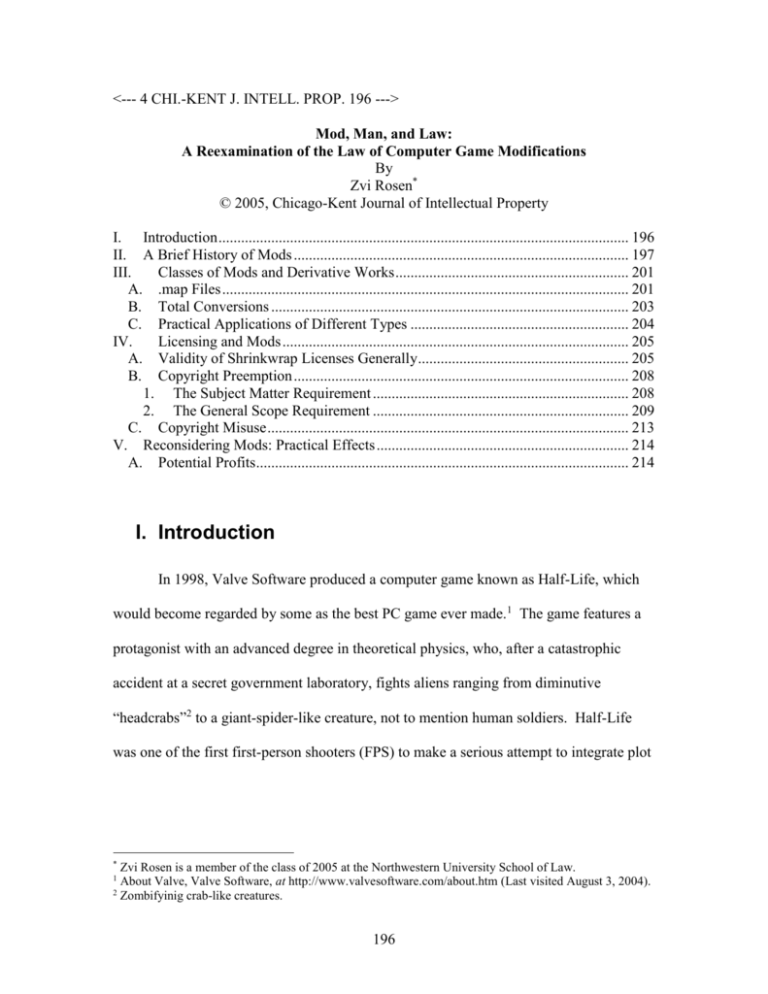
<--- 4 CHI.-KENT J. INTELL. PROP. 196 ---> Mod, Man, and Law: A Reexamination of the Law of Computer Game Modifications By Zvi Rosen* © 2005, Chicago-Kent Journal of Intellectual Property I. Introduction ............................................................................................................. 196 II. A Brief History of Mods ......................................................................................... 197 III. Classes of Mods and Derivative Works .............................................................. 201 A. .map Files ............................................................................................................ 201 B. Total Conversions ............................................................................................... 203 C. Practical Applications of Different Types .......................................................... 204 IV. Licensing and Mods ............................................................................................ 205 A. Validity of Shrinkwrap Licenses Generally ........................................................ 205 B. Copyright Preemption ......................................................................................... 208 1. The Subject Matter Requirement .................................................................... 208 2. The General Scope Requirement .................................................................... 209 C. Copyright Misuse ................................................................................................ 213 V. Reconsidering Mods: Practical Effects ................................................................... 214 A. Potential Profits................................................................................................... 214 I. Introduction In 1998, Valve Software produced a computer game known as Half-Life, which would become regarded by some as the best PC game ever made.1 The game features a protagonist with an advanced degree in theoretical physics, who, after a catastrophic accident at a secret government laboratory, fights aliens ranging from diminutive “headcrabs”2 to a giant-spider-like creature, not to mention human soldiers. Half-Life was one of the first first-person shooters (FPS) to make a serious attempt to integrate plot * Zvi Rosen is a member of the class of 2005 at the Northwestern University School of Law. About Valve, Valve Software, at http://www.valvesoftware.com/about.htm (Last visited August 3, 2004). 2 Zombifyinig crab-like creatures. 1 196 into the missions themselves. It was also one of the first to dispense with the interruptions between missions; instead, one mission flowed directly into another.3 Yet, that game’s most lasting application is not a finely-crafted single-player game. Rather, Half-Life is still played today, over five years after its initial release, because of user-created modifications and add-ons such as ranging in scale from new level maps to total conversions which took the game well beyond its original specifications and dramatically enhanced both the sales and lifetime of Half-Life. These modifications to the original game, often simply called mods, would require the original game to play, but still allow others to create a game all their own. And yet, even while the computer game industry has shifted substantially to favor mods, the law lags far behind, regarding these mods as mere derivative works.4 This piece will argue (1) that this understanding of mods is incorrect based on case and statute law, (2) this understanding of mods as enshrined in software licenses will not be upheld, and (3) that this understanding of mods is to the disadvantage of both the maker of the mod and the maker of the original game. II. A Brief History of Mods Although every genre of games had mods of some kind, this piece will focus on mods to FPS computer games. This is because FPS mods are the most ubiquitous mods 3 Half-Life Review for PC, Gamespot, at http://www.gamespot.com/pc/action/halflife/review.html (Last visited August 3, 2004). A first-person shooter is a game in which the player takes on the view that he would actually have if the situation in the game were real – the view consists of his weapon, his hands holding the weapon, and whatever the view in front of him is. 4 A "derivative work" is a work based upon one or more preexisting works, such as a translation, musical arrangement, dramatization, fictionalization, motion picture version, sound recording, art reproduction, abridgment, condensation, or any other form in which a work may be recast, transformed, or adapted. A work consisting of editorial revisions, annotations, elaborations, or other modifications which, as a whole, represent an original work of authorship, is a "derivative work." 17 U.S.C. § 101. 197 by a significant margin.5 Indeed, FPS mods are the only games with any case law regarding them,6 many well-known FPS mods have been created,7 and FPS mods are mentioned almost exclusively in articles about mods.8 It should further be noted that the issues of modifications and emulators to console games are very different questions.9 This is because console mods and emulators do not change the game play experience beyond allowing the game to play on different platforms or with aspects of the game unlocked automatically.10 Thus, for purposes of this piece, mods are defined as any level-type add-on, up to and including total conversions. Although mods to FPS games encompass more than levels, including such refinements as new weapons, uniforms, and flags, for purposes of this article only levels will be considered, because they do not modify the game play experience so much as create a new one, and thus do not raise additional intellectual property issues mods more minor in scale do raise. Furthermore, mods more minor in scale are often created as parts of a level-type mod. Wolfenstein 3D, which was released in 1992 as the first FPS, has many mods available for it.11 Other games in the pre-3D era such as Duke Nukem 3D, a “very cool”12 game released in early 1996,13 also had many mods available for them.14 5 A search of the internet revealed that the vast majority of sites for mods were for mods to FPSs. Micro Star v. Formgen Inc., 154 F.3d 1107 (9th Cir., 1998). 7 See E.G. Couner-Strike and Day of Defeat (both mods for Half-Life). See infra note 29. 8 See E.G. SALON.COM, Triumph of the Mod, April 16th, 2002, at http://www.salon.com/tech/feature/2002/04/16/modding/print.html (Last visited March 28, 2005). 9 Sony Computer Entertainment, Inc. v. Connectix Corp., 203 F.3d 596 (9th Cir., 2000). An emulator is a software program which mimics (emulates) a hardware console to allow programs designed for the console to run on the new platform. 10 Whereas without the mod these features would only be unlocked once the player completed a certain task, for instance. 11 Macintosh Levels, Wolfenstein 3D Archive, at http://www.mac-archive.com/wolfenstein/maclevels.html (Last visited August 3, 2004). 12 Micro Star, 154 F.3d at 1109. 13 The Apogee FAQ: Section [2.8.14]: Duke Nukem 3D, at http://rinkworks.com/apogee/s/2.8.14.shtml. (Last visited March 28, 2005) 14 Despite the title, these games were not actually three-dimensional. See infra at Pg. 5. 6 198 However, these mods were generally little more than map files that used the game’s existing characters and graphics in ways that were often very similar to (but less professional than) the original game. The only major court decision to deal with whether mods constitute derivative works, Micro Star V. Formgen, dealt with Duke Nukem 3D, one of the last of this older generation of games.15 By the time of the release of Duke Nukem 3D, technology was already evolving in such a way that would make the class of mods seen in Micro Star essentially obsolete. The first factor which influenced the evolution of mods was the development of online play. Originally, first person shooters were single-player only, in which the player battled a series of enemies governed by the game’s artificial intelligence (AI). However, FPS AI has always been weak when compared to a human player (much like artificial intelligence in general); since computers think in substantially different ways than humans, originality in the computer’s tactics is an impossibility, as it has been preprogrammed to react in a certain manner. Furthermore, the computer’s one strength, perfect aim, must be toned down in order to prevent players from feeling at an unfair disadvantage. Online play makes these concerns a thing of the past. The sophistication of the game’s artificial intelligence is a non-issue, since all players are controlled by human intelligence.16 The first successful FPS to support multiplayer gaming was Doom, released in 1993.17 Although at first much online FPS play was still done over maps created for 15 Micro Star, 154 F.3d at 1107 The exception to this is collaborative play, in which multiple human players would compete together against computer-controlled enemies. This style of play was popular in Doom, but has since fallen into disfavor. 17 The Guide – First Person Shooters, at http://www.bluesnews.com/guide/FPS.htm (Last visited March 28, 2005). 16 199 single-player use, in time both mods such as Counter-Strike as well as commercial games like Unreal Tournament were created specifically with online play in mind. Online play liberated mod developers in several ways. Firstly, there was no need to develop new AI enemies or worry how artificial intelligence would deal with a map that the developers of the game’s artificial intelligence had not contemplated. Secondly, it was much easier to create a multiplayer map that does not adhere to the storyline of the original game, since there are no pre-created enemies to fight which hearken back to the story of the original single-player game. Using the story of the original game had made FPS mods derivative works in the past.18 While online play liberated mod developers from dealing with many aspects of game development, the advent of full three-dimensional worlds in first-person shooters once again complicated the process of developing mods. However, the freedom of three full dimensions allowed for much more creativity, and enabled mods to more easily break free of the world of the original game, and from classification as a derivative work. Even though games such as Wolfenstein 3D to Duke Nukem 3D have called themselves threedimensional, they actually were something called “two-and-a-half-D.” Although the other two spatial dimensions were there, the up-down dimension (aka the Y-axis) was not, and graphical tricks were used to disguise this. This limitation effectively resulted in all levels feeling fairly similar, since the maps could not have complexity in three dimensions. Quake, released by id Software in 1996, changed all this, and changed the mod community for good.19 In Quake bridges, multiple floors, and effective lifelike environments could be modeled in full three dimensions and then walked or (more likely) 18 Micro Star, 154 F.3d at 1107 Supra note 17., The Guide – Basics – Quake, at http://www.bluesnews.com/guide/quake.htm (Last visited March 28, 2005). 19 200 fought through. Every major FPS since Quake has used a full three dimensions, with each generation further raising the bar for graphic quality. Although three dimensions are more complicated to work in, they truly liberate mod makers from the limited designs and conventions of the original game, and allow for mods well beyond the mere maps considered in Micro Star.20 III.Classes of Mods and Derivative Works FPS level-type mods fall into two distinct classes, each of which has different implications for intellectual property purposes. Additionally, most mods fall somewhere in between the two classes, resulting in a situation requiring case-by-case analysis to determine which class it fits more fully into. A. .map Files A .map file is the simplest type of mod, and the only one the law has directly addressed.21 A map file instructs the game engine how to place the game’s own artwork in such a way that produces a navigable level. The file contains no artwork or image files of any kind, nor does it contain artificial intelligence or other enhancements to alter the look of the level beyond the look of the original game. The Ninth Circuit has already considered whether or not .map files can be considered derivative works.22 In Micro Star, upon the determination that the map file is fixed in a 20 Micro Star, 154 F.3d at 1107. Id at 1110. 22 Id at 1107. 21 201 permanent medium on the CD, the court found two considerations as to whether the .map files were derivative works.23 1. The level must not be substantially similar in both ideas and expression.24 2. The level must not use the story of the original game in any way.25 The court in Micro Star found that the first criterion would always be met when the level used only the game’s own art library, as a .map file does.26 Since the second criterion was met in Micro Star, it will also be met in essentially all cases of .map files in singleplayer games. The second criterion essentially consists of is the right to create sequels.27 Fairly substantial work is required to take a mod out of the realm of being a sequel, and into the realm of being an independent creative work. It is simply not possible to do this with a .map file, which cannot provide anything new save for a different alignment of the existing story. Multi-player maps (especially for Duke Nukem 3D under the “Dukematch” category) often have no plot,28 and are thus not sequels in the traditional sense. However, the court in Micro Star did not differentiate them, giving the implication that the story is conveyed by the look and feel of a burned-out Los Angeles. Furthermore, it is possible that only FPS games based on real-life events (such as World War 2), with .map files used for plot-less multiplayer matches, would not satisfy the second prong of this test, and thus would not be considered derivative works. Aside from that, .map files, the most traditional form of FPS mod, will be considered derivative works. As such, other issues such as licensing need not be raised. 23 Id. It seems clear that a hard drive can be considered a fixed medium, especially in light of RAM being a fixed medium. MAI Systems Corp. v. Peak Computer, Inc., 991 F.2d 511, 518-19 (9th Cir.1993). 24 Id. at 1112 (Quoting Litchfield v. Spielberg, 736 F.2d 1352, 1356 (9th Cir.1984)). 25 Id. 26 Id. 27 Id. 28 Duke 3D Maps, at http://members.tripod.com/~duke3d/maps.htm (Last visited December 19, 2004). 202 B. Total Conversions The holding in Micro Star should not be interpreted to hold that all mods are derivative works. Total conversions, which occupy the opposite end of the mod spectrum from .map files, are not derivative works under any application of statute or case law. A total conversion is essentially a whole new game, only recognizable as a mod due to its use of the underlying original game. Many of the most famous mods, such as CounterStrike, are included in this category.29 The graphics are new, game play mechanics are altered, and little if any of the surface of the original game remains.30 A total conversion also has a new storyline.31 Given these considerations, a total conversion falls afoul of neither of the prongs from Micro Star,32 and stands directly aligned with them. The total conversion will not be substantially similar to the original in ideas and expressions because there is no art in common, and a completely new world is the setting for the mod. The second prong is fulfilled by definition, as a total conversion does not use any part of the original game’s story. This makes sense from a logical standpoint. Although a total conversion is technically a mod, nothing remains of the original game except the underlying engine. Although there is some evidence that the underlying game engine is viewed as 29 Counter-Strike is a mod to Half-Life which, rather than being set in a science-fiction environment, is a multiplayer online counter-terrorist/terrorist game. Game modes include assassination, bomb/defuse, and hostage rescue. CSBANANA - Counter-Strike > About Counter-Strike, at http://www.csbanana.com/csb_page.banana?page=4 (Last visited March 28, 2005). It owes little to the original game save the use of the engine, and indeed has been subsequently marketed by the maker of HalfLife as a stand alone game. Counter-Strike Team Partners with Valve, News, The Official Half-Life Web Site, April 11th, 2000, at http://half-life.sierra.com/ (Last visited March 28, 2005). At its height, it was more popular than any commercially released multiplayer FPS. Counter-Strike Feature, Firingsquad.com, at http://www.firingsquad.com/games/counterstrike66/page8.asp (Last visited March 28, 2005). 30 UnrealWiki: Making Mods, at http://wiki.beyondunreal.com/wiki/Making_Mods (Last visited December 21, 2004) (Last visited March 28, 2005). 31 Id. See E.G. Ambrosia Software Web Board, at http://www.ambrosiasw.com/forums/lofiversion/index.php/t18606.html (Last visited December 21, 2004). 32 Micro Star, 154 F.3d at 1112. 203 copyrightable,33 this is a misconception. The game’s underlying engine is a purely functional element, embodying no conception of artistic merit or beauty, and as such is not copyrightable.34 In any case, since the engine is not included with the mod, the user of the mod must still procure the original game. This use of the original game’s licensed engine leads to other questions, such as: should the maker of the game prohibit licensees from using the game engine to run a mod? C. Practical Applications of Different Types In reality, most mods fall somewhere in between these two extreme forms of total conversions and .map files. Either the mod will be a total conversion which implicates the original game’s plot, such as Duke Nukem fighting terrorists, or a level which includes a bit of the art of the original game. The question then is whether the look and feel of the original game has been reproduced, and whether the story of the original game has been used. Most mods will fall into this middle ground, and whether they are derivative works needs to be decided on a case-by-case basis, following the guidelines from Micro Star. If the game is a derivative work, then it is the property of the maker of the original game, and they may do what they will with it. If it is not a derivative work, then it is an original work of creative expression, and thus a stand-alone copyrightable work. However, even if the mod is not a derivative work, the question remains whether the mod can be used on top of a game engine that is licensed to prohibit its use to run mods.35 33 Unreal Tournament / contest, at http://www.unrealtournament.com/ut2003/contest_overview.php (Last visited December 23, 2004). 34 Bleistein v. Donaldson Lithographing Co., 188 U.S. 239 (1903). 35 This includes derivative works that successfully use Fair Use as an affirmative defense. 204 IV. Licensing and Mods Even if copyright fails to prevent the creation or sale of a mod, a user may still be prohibited from using the mod on top of the existing game because it can still be protected by a contract such as a “shrinkwrap” license agreement.36 When one purchases a game, it generally remains the exclusive property of the manufacturer under the license agreement governing the use of the game, which a user is required to read before installation. Although the game’s engine is not copyrightable,37 one may still be prohibited from using it to run a mod by provisions in the game’s shrinkwrap agreement.38 A. Validity of Shrinkwrap Licenses Generally There are several ways that a shrinkwrap agreement can be invalid. First, the shrinkwrap agreement, due to placement or other issues, may not represent a valid contract between parties.39 Second, it can violate a portion of general contract law.40 This provision, while important, is usually avoided by decent license-writing, and can be assumed to not be a factor. Third, the license may grant copyright-type protection to material not copyrightable, and thus be preempted by the Copyright Act.41 Finally, the 36 So called because they used to be put on the shrinkwrap covering the product. Eric S. Freibrun, Court Strikes Down Shrink-Wrap License Agreement, at http://www.freibrunlaw.com/articles/articl22.htm (Last visited December 23, 2004). 37 The game’s engine is a purely functional element, and thus not covered by the copyright statute. Infra at III(B). 38 The contract one agrees to by opening the shrinkwrap and using the product. 39 Step-Saver Data Sys., Inc. v. Wyse Technology, 939 F.2d 91 (3D Cir.1991). 40 ProCD, Inc. v. Zeidenberg, 86 F.3d 1447, 1449 (7th Cir. 1996) (hereinafter ProCD 2) (Concludes that shrink wrap licenses are enforceable as long as they do not violate general contract law). 41 17 U.S.C. § 301(a); See National Car Rental System, Inc. v. Computer Associates Intern., 991 F.2d 426 (8th Cir. 1993)(hereinafter National Car Rental); Computer Assocs. Int'l, Inc. v. Altai, Inc., 982 F.2d 693, 716 (2d Cir.1992). 205 license agreement may fall afoul of copyright misuse.42 Each issue must be determined on a case-by-base basis, but the general contours of each question can be generalized. Some courts recognize shrinkwrap licenses as almost always valid.43 However, these courts are “a minority.”44 A majority of courts see shrinkwrap licenses as “contracts of adhesion, unconscionable, and/or unacceptable pursuant to the U.C.C.”45 Additionally, state laws to specifically validate shrinkwrap licenses have been held to be pre-empted by federal copyright law.46 The problem with viewing shrinkwrap contracts as agreed-upon exchanges is that “[i]n most transactions, the purchaser does not become aware of the terms of the license until after the sale is consummated, even though most software purchasers are aware of the existence of a shrinkwrap license.”47 The court in Step-Saver held that a shrinkwrap agreement between two merchants was nonbinding pursuant to UCC § 2-207 due to these concerns.48 Language on a software box that said that an end user agreed to be bound by the terms of service for the software enclosed within was “not sufficient to render [the manufacturer’s] acceptance [of the user’s offer] conditional.”49 Furthermore, the court found that the manufacturer was willing to forgo 42 Lasercomb America, Inc. v. Reynolds, 911 F.2d 970, 977 (4th Cir. 1990); DSC Communications Corp. v. DGI Technologies, Inc., 81 F.3d 597, 601 (5th Cir. 1996); Practice Management Information Corp. v. American Medical Ass'n, 121 F.3d 516, 520-521(9th Cir. 1997); Video Pipeline, Inc. v. Buena Vista Home Entertainment, Inc., 342 F.3d 191, 203-204(3rd Cir. 2003). 43 ProCD 2; Microsoft v. Harmony Computers, 846 F.Supp. 208, 212 (E.D.N.Y.1994). 44 Novell, Inc. v. Network Trade Center, Inc., 25 F.Supp.2d 1218, 1230 (D.Utah 1997), decision partially vacated on other grounds 187 F.R.D. 657 (D.Utah 1999). 45 Id (Citing Step-Saver, 939 F.2d at 91). See also Batya Goodman, Honey, I Shrink-Wrapped the Consumer: the Shrinkwrap Agreement as an Adhesion Contract, 21 CARDOZO L.REV. 319, 344-352 (1999). 46 Vault Corp. v. Quaid Software Ltd., 847 F.2d 255, 269-270 (5th Cir.1988) 47 Lloyd L. Rich, Mass Market Software and the Shrinkwrap License, 23 COLO. LAW. 1321 (1994). Although the assertion that most purchasers are aware of the existence of a shrinkwrap license seems wellaccepted, it is questionable factually, and no support for the assertion is given. See Novell, 25 F. Supp.2d at 1230 N. 17 (saying that end users are confronted with a new set of restrictions they were not aware of when they purchased the product). 48 Step-Saver, 939 F.2d at 102; UCC § 2-207 49 Step-Saver, 939 F.2d at 102. 206 the additional terms in the shrinkwrap agreement just to get the user to use their product.50 This argument has formed the core of other shrinkwrap cases.51 In recent years there have been several decisions following the Seventh Circuit’s decision in ProCD 2, which essentially limited Step-Saver to contracts between merchants, while not holding it applicable to individual end-users. 52 However, the court’s decision in ProCD 2 was partially premised on the holding that UCC § 2-207 was inapplicable to that case, which was directly contradicted by the official comment.53 The decision in ProCD 2 has also been criticized on public policy grounds as limiting the rights of the consumer.54 At the same time, other jurisdictions have rejected the holding of ProCD 2.55 Ultimately, despite fairly convincing arguments for not holding shrinkwrap agreements as legitimate as they bind consumers to terms they were unaware of when purchasing the software, there is a circuit split on the issue. If the issue takes place in a jurisdiction that does not recognize shrinkwrap agreements, then only copyright agreements are of concern. However, if one is in a jurisdiction (such as the Seventh Circuit) which recognized shrinkwrap contracts as valid, then the mod-maker needs to look at ways to circumvent the license agreement. 50 Id. I.Lan Systems, Inc. v. Netscout Service Level Corp., 183 F.Supp.2d 328, 337 (D.Mass. 2002). 52 M.A. Mortenson Co., Inc. v. Timberline Software Corp., 140 Wash.2d 568, 998 P.2d 305 (license agreement supplied with software); Rinaldi v. Iomega Corp., 1999 WL 1442014, Case No. 98C-09- 064RRC (Del.Super. Sept. 3, 1999) (warranty disclaimer included inside computer Zip drive packaging ); Westendorf v. Gateway 2000, Inc., 2000 WL 307369, Case No. 16913 (Del. Ch. March 16, 2000) (arbitration provision shipped with computer); Brower v. Gateway 2000, Inc., 246 A.D.2d 246, 676 N.Y.S.2d 569 (N.Y.App.Div.1998) (same); Levy v. Gateway 2000, Inc., 1997 WL 823611, 33 UCC Rep. Serv.2d 1060 (N.Y.Sup. Oct. 31, 1997) (same) 53 Thomas J. McCarthy et al., Survey: Uniform Commercial Code, 53 BUS. LAW. 1461, 1465-66 (1998) 54 Jeremy Senderowicz, Consumer Arbitration and Freedom of Contract: A Proposal to Facilitate Consumers' Informed Consent to Arbitration Clauses in Form Contracts, 32 COLUM. J.L. & SOC. PROBS. 275, 296-299 (1999) 55 Klocek v. Gateway, Inc., 104 F.Supp.2d 1332, 1337-38 (D.Kan. 2000). 51 207 B. Copyright Preemption Section 301(a) of the Copyright Code says explicitly that the federal copyright statute will preempt a state common-law contract claim where 1. “the work is within the scope of the subject matter of copyright” and 2. “the rights granted under state law are equivalent to any exclusive rights within the scope of federal copyright.”56 These have been summarized as the (1)“subject matter requirement” and (2)“general scope requirement.”57 “The declaration of this principle in section 301 is intended to be stated in the clearest and most unequivocal language possible, so as to foreclose any conceivable misinterpretation of its unqualified intention that Congress shall act preemptively, and to avoid the development of any vague borderline areas between State and Federal protection.”58 1. The Subject Matter Requirement Although the game engine is not copyrightable, this does not mean it is not within the subject matter of copyright. There is a consensus among commentators that whether or not something is actually copyrightable, as long as it is of the general type that copyright protects, it fulfills the subject matter requirement.59 Not only is the preemption 56 17 U.S.C. § 301(a); See Rosciszewski v. Arete Assoc., Inc., 1 F.3d 225, 229 (4th Cir.1993)(quoting Ehat v. Tanner, 780 F.2d 876, 878 (10th Cir.1985)), Briarpatch Ltd. v. Phoenix Pictures, Inc., 373 F.3d 296, 305 (2nd Cir.2004). 57 National Basketball Ass'n v. Motorola, Inc., 105 F.3d 841, 848 (2d Cir.1997), See also Lipscher v. LRP Publications, Inc., 266 F.3d 1305, 1311 (11th Cir. 2001). 58 Daboub v. Gibbons, 42 F.3d 285, 290 n. 8 (5th Cir. 1995) (quoting H.R.Rep. No. 1476, 94th Cong.2d Sess. 130 (1976), U.S.Code Cong. & Admin.News 1976, 5659, 5746) (emphasis in citing source). 59 ProCD 2 at 1453 (Citing ProCD 1, Inc. v. Zeidenberg, 908 F.Supp. 640, 650-651 (W.D.Wis.1996) (hereinafter ProCD 1) Paul Goldstein, III COPYRIGHT § 15.2.3 (2d ed.1996); Melville B. Nimmer & David Nimmer, NIMMER ON COPYRIGHT § 101[B] (1995); William F. Patry, II COPYRIGHT LAW AND PRACTICE 1108-09 (1994)). 208 section of the copyright statute meant to prevent states from adding protections to works covered by copyright, “[o]ne function of § 301(a) is to prevent states from giving special protection to works of authorship that Congress has decided should be in the public domain, which it can accomplish only if ‘subject matter of copyright’ includes all works of a type covered by sections 102 and 103, even if federal law does not afford protection to them.”60 There is nothing doctrinally different between a purely functional database (as in ProCD) and a purely functional game engine. Conseqently, there is little argument that the purely functional uncopyrightable database fulfills the subject matter requirement.61 Given this, essentially any content covered by a software license is covered by the subject matter requirement. The question is more complicated for the general scope requirement. 2. The General Scope Requirement In order to prove the general scope requirement, the state law claim requires an extra element that makes it “qualitatively different” from a federal copyright infringement claim.62 “Conversely, when a state law violation is predicated upon an act incorporating elements beyond mere reproduction or the like, the rights involved are not equivalent and preemption will not occur.”63 Merely breaching an implied promise to pay has not been held sufficient to constitute an extra element.64 While several courts 60 Id. (Citing Bonito Boats, Inc. v. Thunder Craft Boats, Inc., 489 U.S. 141, 109 S.Ct. 971, 103 L.Ed.2d 118 (1989) (illustrating the same principle in a patent setting)). 61 Id. 62 Summit Mach. Tool Mfg. Corp. v. Victor CNC Sys., Inc., 7 F.3d 1434, 1440 (9th Cir.1993) (quoting Balboa Ins. Co. v. Trans Global Equities, 218 Cal.App.3D 1327, 1342, (1990)). 63 Wrench at 850(citing Harper & Row Publishers, Inc. v. Nation Enters., 723 F.2d 195, 200 (2d Cir.1983), rev'd on other grounds, 471 U.S. 539, 105 S.Ct. 2218, (1985)). 64 Wrench at 853; Endemol Entertainment B.V. v. Twentieth Television, Inc., 48 U.S.P.Q.2d 1524, 1528 (C.D.Cal.1998); Tavormina v. Evening Star Productions, Inc., 10 F.Supp.2d 729, 734-35(S.D.Tex.1998) (mem.op.). 209 have attempted to severely limit what contract claims will be preempted by the copyright statute,65 they have limited themselves from being categorical.66 Meanwhile, several recent cases have found that a breach of contract claim requires more than mere use by a licensee in violation of the agreement.67 National Car Rental dealt with National Car Insurance’s use of Computer Associates’ (“CA”) software in their data center in Minnesota.68 Even though CA’s license prohibited National from allowing anyone else to use their software, CA subsequently found that National was doing this.69 The district court, in finding preemption, found that the section at question, prohibiting unjust enrichment from the program, was preempted by the copyright act, which lists distribution as a protected right.70 The court of appeals overturned, framing the question as ‘whether the right in question is ‘infringed by the mere act of reproduction, performance, distribution or display’”71 Furthermore, “if an extra element is ‘required, instead of or in addition to the acts of reproduction, performance, distribution or display, in order to constitute a statecreated cause of action, then the right does not lie 'within the general scope of copyright' and there is no preemption.’”72 The court found that the contract claim would not exist if 65 ProCD 2, 86 F.3d at 1447. Wrench at 851-52. 67 Huckshold v. HSSL, L.L.C., 344 F.Supp.2d 1203 (E.D.Mo. 2004) (distinguishing non-preempted copying by a third party from copying by licensee themselves); Evolution, Inc. v. SunTrust Bank, 342 F.Supp.2d 943 (D.Kan. 2004) (finding that a breach of contract claim that was filed by a software development against a licensee that alleged improper modification of software was preempted by copyright law); Firoozye v. Earthlink Network, 153 F.Supp.2d 1115, 1126 (N.D.Cal.2001) (a claim “that a defendant violated a promise not to use a certain work” is preempted). 68 National Car Rental, 991 F.2d at 427. 69 Id at 428. 70 National Car Rental System, Inc. v. Computer Associates Intern., Inc., 22 U.S.P.Q.2d 1375, 1378 (D.Minn. Jan 17, 1992),; See 17 U.S.C.A. § 106. 71 National Car Rental, 991 F.2d at 431 (citing 1 NIMMER ON COPYRIGHT § 1.01[B], at 1-13). 72 Id. (citing 1 NIMMER ON COPYRIGHT § 1.01[B], at 1-14-15). See Rosciszewski v. Arete Associates, Inc., 1 F.3d 225, 229-230 (4th Cir.1993); See also BVS Performance Systems, Inc. v. Mercantile Bancorporation, Inc., 2000 WL 34031502 at 3 (N.D.Iowa Apr 24, 2000) (NO. C98-111 MJM) 66 210 the contract did not exist, and as such that there was no preemption. Although this seems similar to the case of game mods, that similarity is mostly superficial, stemming from the fact that both cases involve a computer program’s license agreement. Whereas National Car Rental implicated the right to distribute works, computer game mods implicate the right to create derivative works (even if not all mods are necessarily derivative works). Whereas in National Car Rental the user would have had an unlimited right to allow others to use the software (since no copies were being made), regarding computer game mods, the license agreement attempts to regulate the same things as the statute does regarding (arguably) derivative works. Thus the standard found in National Car Rental favors a finding of preemption in cases of computer game mods. An alternative view was presented in ProCD 2. The district court in ProCD, Inc. v. Zeidenberg found that a license was preempted because the license in question was a shrinkwrap license that was invalid.73 The Court of Appeals reversed, significantly narrowing the scope of copyright preemption in the Seventh Circuit.74 A company had gone to a significant expense to create and market a telephone directory on CD-ROM.75 A user then purchased the software “and decided to ignore the license.”76 This user proceeded to offer the contents of the (not copyrightable) database online at a far cheaper rate than the original company, and the original company sued for violation of its copyrights and license.77 In an opinion by Judge Easterbrook, the Seventh Circuit did not analyze whether the portion of the license agreement in question was within the general 73 ProCD 1 at 650 ProCD 2 at 1447 75 Id at 1449. 76 Id at 1450. 77 Id. 74 211 scope of the Copyright Act.78 Rather, the question was investigated from an economic standpoint, and decided on those concerns that breach of contract claims would essentially never be preempted.79 Many courts have rejected the extremely expansive view of ProCD 2.80 Indeed, to take this view would be to essentially gut section 301(a) of the Copyright Code, a position that directly violates the congressional intent: The intention of section 301 is to preempt and abolish any rights under the common law or statutes of a State that are equivalent to copyright and that extend to works coming within the scope of the Federal copyright law. The declaration of this principle in section 301 is intended to be stated in the clearest and most unequivocal language possible, so as to foreclose any conceivable misinterpretation of its unqualified intention that Congress shall act preemptively, and to avoid the development of any vague borderline areas between State and Federal protection.81 Rather, courts have embraced the view in National Car Rental and the like, and agree that it is a question of whether the (potential) right would exist absent the license agreement.82 Even though in many cases game mods are not actually derivative works, this is rarely incontestable, and as such they are still very much of the type of derivative works. License provisions that seek to prevent the creation of derivative works protect a right against the creation of derivative works independent of the license, and as such are preempted by section 301 of the Copyright Code. 78 Id at 1454. Id at 1454-1455. 80 See E.G. American Movie Classics Co. v. Turner Entertainment Co., 922 F.Supp. 926, 931 (S.D.N.Y.1996); See also Ballas v. Tedesco, 41 F.Supp.2d 531, 537 N.14 (D.N.J. 1999) (interpreting ProCD 2 as not holding all breach of contract cases non-preempted); Green v. Hendrickson Publishers, Inc., 770 N.E.2d 784, 787-88 (Ind. 2002) (Decision by state court in seventh circuit finding a breach of contract claim preempted). 81 H.R.Rep. No. 94-1476, at 130 (1976). 82 Wrench at 849-53. 79 212 C. Copyright Misuse Copyright misuse is facially similar to copyright preemption, but quite different doctrinally, wider ranging, and less frequently recognized by the courts.83 Recognized in a few circuits,84 this is essentially a public policy doctrine that does not reward entities “engaged in certain sorts of misconduct in licensing or enforcing the copyright.”85 It should be noted that copyright misuse goes significantly beyond the contours of antitrust law, in contrast to patent misuse. Although this doctrine covers a wider swath than preemption, it is also more limited, in that it only applies in copyright cases, and will not apply in cases where the copyright is unclear or the material is not copyrightable.86 However, in cases where the mods are derivative works, the fact that “copyright misuse is a fact-specific doctrine tailored to the circumstances of individual cases, it may prove a better tool both for tailoring copyright incentives and for avoiding the reticence that surrounds coarser tools such as preemption.”87 Copyright misuse will most likely be a tool of last resort should other attempts to avoid the license fail. For instance, perhaps ProCD would have been decided in a different way if copyright misuse were a valid doctrine in the Seventh Circuit.88 83 Mark A. Lemley, Beyond Preemption: The Federal Law and Policy of Intellectual Property Licensing, 87 CALIF. L. REV. 111 (1999). 84 Supra note 42. 85 Lemley, Supra note 83 at 151. 86 Id at 157. 87 Id at 157-158. 88 Mitchell Zimmerman, The Wrong Way: Copyright Misuse Weakens Infringement Claims, LOS ANGELES DAILY JOURNAL, Practitioner column, Sept. 19, 1997, Available at http://www.fenwick.com/docstore/publications/IP/IP_Articles/The_Wrong_Way.pdf (Last visited December 24, 2004). 213 V. Reconsidering Mods: Practical Effects Even if the license is valid or the mod is a derivative work, there are still many reasons why PC Game Manufacturers have it in their interest to reconsider mods to PC games relative to the law. Chief among these reasons is that there are substantial profits to be had by embracing mods as a way to heighten the value of their intellectual property. While currently there is a thriving nonprofit/enthusiast mod community, the quality and quantity of mods could be further enhanced by allowing mod-makers to profit from their creations.89 A. Potential Profits Currently, manufacturers of PC Games do not allow the creation or use of mods for profit. The rationale for this is that it undercuts the market for the original game and official add-on packs, and weakens the manufacturer’s legal hold on the game. The former is pure nonsense. As seen with Half-Life, mods supplement, and do not replace, demand for the original game. Indeed, since the original game is required to play the mod, a good enough mod can actually increase sales of the original game, as it has for Half-Life. Furthermore, good enough mods will also enhance the shelf life of the game, by keeping it new and fresh well after the official development team has moved on to other projects. Official add-on packs seldom merely add a few new levels. They add new weapons and features, which mod developers can, in turn, incorporate into their mods. This can then drive demand for the official add-on package, which would be 89 Not that this would supplant enthusiast-created mods. It would merely extend the market. 214 required as well to play these new mods. In effect, mods are free money for computer game developers. So why do they not allow mod developers to have a profit incentive? A few total conversions have made their way into being full-fledged commercial add-ons. In these cases, the maker of the original game tends to hire away the team that developed the mod, rather than paying for the mod.90 While it generally pleases the mod developers to graduate to professional game development, the truth is they became professionals the moment the maker of the original game decided the mod was worth selling. Subsequently, the mod developers’ intellectual property rights are effectively ignored. Rather, developers of total conversions should be allowed to sell their mods as they see fit, provided they do not include the original engine so as to allow it to run independent of the original game, and provided that it is not grossly offensive and does not violate the copyrights of others. This would be a perfect opportunity for many fledgling game developers to develop a commercial product without dealing with all the engine development issues inherent to the production of a full game. Both parties would benefit from such opportunities for developers, and for the community of mod developers to go beyond enthusiasts with time on their hands. Here there is no worry about showing a weakened hold on the intellectual property rights of the game, as those rights don’t cover total conversions anyway. Developers of less ambitious mods should be able to sell their works through the maker of the original game, where they would be paid a certain fee for the development, and the company would take most of the fee for distribution. This would be a very good 90 See e.g. Counter-Strike, Wikipedia, at http://en.wikipedia.org/wiki/Counter-Strike (Last visited December 24, 2004); DICE Hires Desert Combat Developers, 11 COMPUTER GAMING WORLD 7 (July 2004) (The maker of the original game “realized early on that Desert Combat was a good thing for the franchise”). 215 way for game companies to encourage small mods that dramatically increase the functionality of the game, or implement in an ingenious way something they had not considered at the time. Under this proposed model, both parties would benefit financially and creatively. Computer game mods have substantially evolved from the days when they were gray market afterthoughts to commercial games. Developers of games like Half-Life 2 and Doom III openly support the creation of mods for their game by giving detailed access to information required to make mods of the maximum quality.91 While the relationship of mods to the computer game industry has shifted, the law’s view of mods has not, and this has been a mistake. Modern-day game developers actually plan on good mods dramatically extending the shelf life and increasing demand for the game. Some mods are not derivative works, and when we stop treating them as mods and treat them as legitimate software packages all their own, incentives to create better mods will further increase, resulting in benefits to everyone on the value chain. 91 Tim Surette, Valve Releases Source SDK Tools, GAMESPOT, 11/05/2004, at http://www.gamespot.com/pc/action/halflife2/news_6112599.html (Last visited March 11, 2005) (Half-Life 2 mod development tools were released prior to the release of the actual game). 216

